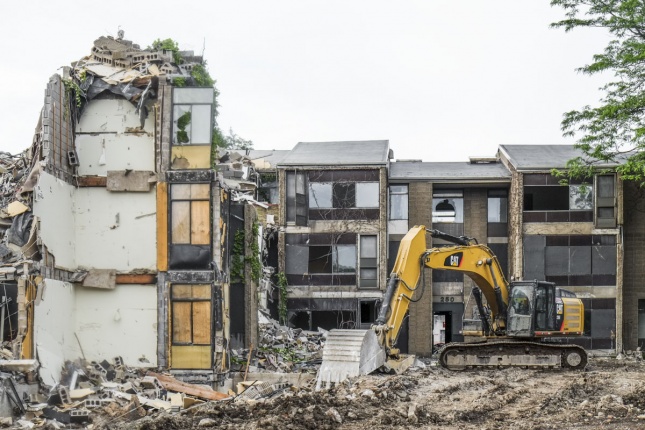As Christopher Hawthorne moves on from the Los Angeles Times and as new forms of criticism proliferate, we asked the architecture community what the role of the critic is today, and what it might be missing.
What do you see as the role of the critic in architecture today? Why is it important?
What aspects of architecture are not being addressed today by critics? What are the problems with criticism today?
Here are the responses we received from critics across the country and abroad. This article was originally published in our May print issue. Stay tuned for further perspectives from practitioners, emerging architects, and scholars.
Mark Lamster
The architecture critic of The Dallas Morning News and a professor at the University of Texas at Arlington. His biography of Philip Johnson, The Man in the Glass House, will be out this November.
“I think there was a sense, in the 1990s and early aughts, that criticism had become too absorbed with signature buildings by the architectural jet-set, mainly because that was what was coming out of the New York Times under Herbert Muschamp. But over the last decade or so, the field has expanded to address a broad spectrum of urban issues, as it should if it’s going to keep the public engaged. The irony here is that the backlash to the era of ‘starchitecture’ (and I hate that term) has meant a certain vilification of and disregard for the discipline. So I think it’s important to celebrate quality architecture and to make clear how important it is to making places that can improve people’s lives every day.”
Alexandra Lange
The architecture critic for Curbed. Her newest book is The Design of Childhood: How the Material World Creates Independent Kids.
“These questions, and this debate, make me tired. What other critics are asked to justify their existence time and again? I believe my work is valuable, and I choose to believe an ‘architecture critic’ can write about almost anything at the intersection of design and the public. The problems of criticism are the problems of journalism: lack of resources, a flocking to the popular, and lack of diversity.”
Witold Rybczynski
Architecture critic for Slate, WigWag, and Saturday Night. His latest book is Now I Sit Me Down.
“I’ve always thought that journalistic architectural criticism was an odd bird. Compared to restaurant, book, or theater reviews, reviews of buildings have little immediate effect on the public. Once a building is built, it’s there, for better or worse, and we must learn to live with it. In any case, reviews based on press kits, guided tours, or interviews with the architect are unlikely to yield profound insights. Theoretically, reviews of as-yet-unbuilt work might be more influential. The problem is that critics generally don’t have the information, resources, or time to make considered judgments. These limitations are compounded when criticism is driven by the need to produce up-to-the-minute newsworthy copy.
Having said that, writing about architecture can be valuable. Buildings last a long time, and it’s useful to reflect on their utility—what works and what doesn’t—and their meanings in our lives. Of course, this is best done in the fullness of time, decades after the building opens, when the sharp corners have been knocked off, so to speak. The result is more like cultural observation than reporting.
A word about the internet, whose many architectural websites have resulted in a boom in architectural criticism. Sadly, it has also produced more hurriedly written, harshly polemical, and poorly researched prose than ever before.”
Frances Anderton
Writer, curator, and host of DnA: Design and Architecture, a weekly radio show broadcast on KCRW public radio station in Los Angeles.
“It was easier to be a critic when you were crusading for modernism, or another -ism, from a podium at a highly-regarded publication. Whether that ultimately gave society better buildings is an open question.”
Barry Bergdoll
Meyer Schapiro Professor of Modern Architectural History at Columbia University and curator in the Department of Architecture and Design at the Museum of Modern Art.
“The role of the architecture critic has not shifted in its most vital importance since the first evidence of it as a professional activity commanding respect and authority in the public sphere with articles criticizing the urban policies of Louis XV in Paris in the mid-18th century. Namely, the architecture critic sets out to forge a bridge between the professional activity of the designing architect and the role of a citizenry by having an informed opinion about the changing environment in which they live. Of course, like an art critic, the architecture critic can contribute to the acclaim of a specific designer; but that is only the beginning of the capacity of the architecture critic to form public opinion. The role is not precisely the same for a critic writing in a publication—printed, broadcast, or on the internet—that primarily serves the profession, and the unfortunately much smaller set of architectural criticism that is aimed at the general public.
The paradox nature of architecture is that it is the most omnipresent of art forms and yet the one that the non-professional audience often has the least capacity to judge. This puts a huge responsibility on the shoulders of the ever-rarer figure of the architecture critic with a broad mandate, namely the shockingly small handful of critics writing in the daily press of national and local record. Here the critic serves to educate at once public and public officials. It is the role of the critic to raise the issues that matter, to frame them in a way that both voters and elected officials and private sector actors in shaping the public realm can understand not only what is at stake but the vital relationship between intelligent design and enhanced environments. It is the difficulty of this task that makes so many nostalgic for a handful of legendary figures like Ada Louise Huxtable at the New York Times or Allan Temko of the San Francisco Chronicle, brilliant writers and thinkers whose texts were easy of access and whose capacity to craft public opinion inspired admiration, awe, and even fear where needed. Few critics are able to achieve the needed balance between the appreciation of the formal invention of architecture and the public issues at stake in most projects.”

Oliver Wainwright
Architecture and design critic of The Guardian.
“The role of an architecture critic is not simply to critique architecture, providing an opinion on the quality of the latest buildings, but to unpick and expose the planning policies, funding sources, and political agendas that shape the built environment and frame projects in their wider societal contexts.
Architectural publishing is facing a number of hurdles, not least in the dwindling number of advertisers paying ever less for space in magazines with shrinking circulation figures, wounded by the rise of free online content. Magazines are increasingly reliant on sponsored advertorials, lucrative awards programs, and other commercial partnerships to stay afloat, while many national newspapers have given up on covering the subject—of the eight national broadsheet papers in the UK, only three now have a regular architecture critic.”
Justin Davidson
Author and architecture and classical music critic for New York magazine. His latest book is Magnetic City: A Walking Companion to New York.
“Construction always involves tradeoffs and often emerges from an adversarial process, fueled by agendas that are both overt and hidden. The reporter/critic is in a unique position to ask questions of all sides, absorb the technical detail, and pass on to the public a point of view that is backed up by clarity and explanation. My hope is that when readers don’t agree with me, at least they know why.
In order to be effective, architecture critics have to look beyond architecture. I got into this business because I loved writing and I loved beautiful buildings. The deeper I dive, the more aware I am of the overlapping areas of expertise that get called into play every time the easy equipment shows up: finance, planning, zoning, activism, preservation, politics, performing arts, engineering, retail, gentrification, transit, industry, the waterfront, housing policy, climate change, social history, literature, psychology, acoustics, and more. I’m gratified to see that critics for general interest publications (as opposed to specialized ones) have a broad sense of their field. It’s rare these days to see a review that focuses on the building as aesthetic object, the exemplar of a style, or the incarnation of a theory. I also think that most critics consider themselves reporters, too, which is essential.
What’s missing is numbers: every city builds, people in every city live and work in works of architecture, and yet the number of papers that cover this crucial element of local news is tiny. The perception that architecture is a specialist’s turf – and therefore of little interest to most readers – is contradicted by the passionate feelings that so many residents have (and express!) over what does and doesn’t get built in their community. The other thing that’s missing is a willingness to revisit buildings a year or two or more after they’ve opened to see how they fare in the real world. Too often, we see buildings in their pristine (or even incomplete) state, empty and theoretical. When I first visited the Whitney, for example, I missed a lot of the basic circulation and functionality problems that materialized later. I didn’t notice how maddening the coat check system was until I saw 100 people trying to check their coats at the same time.”











